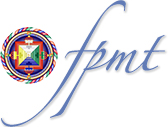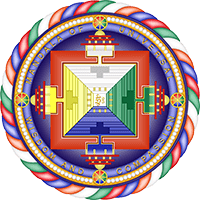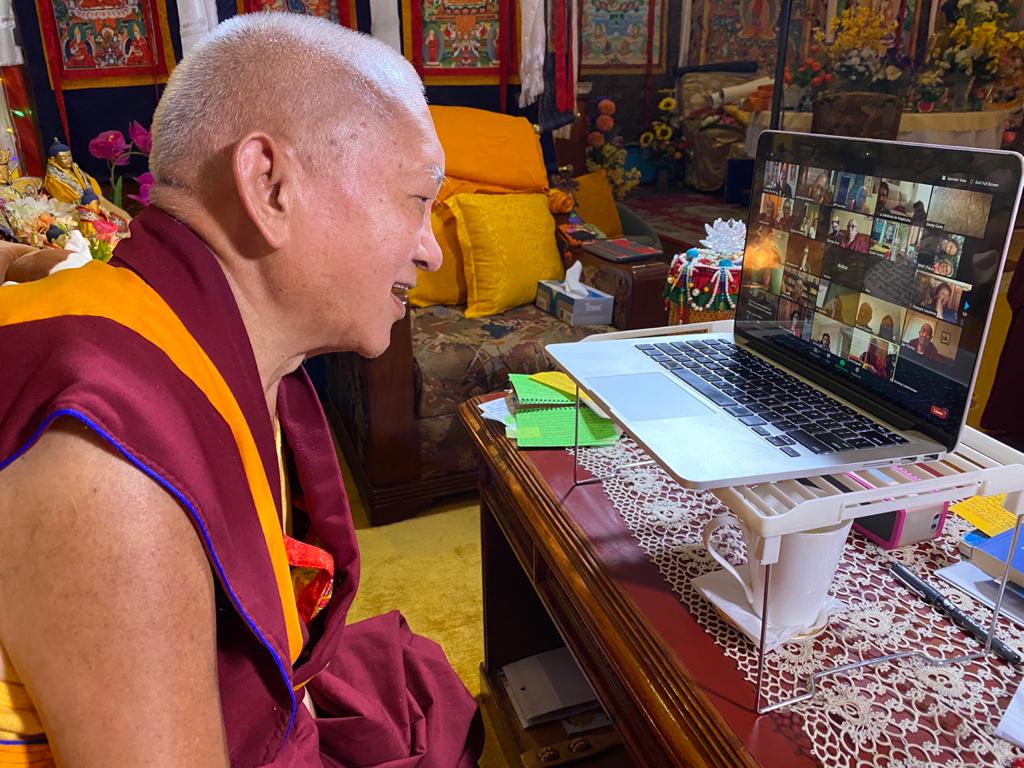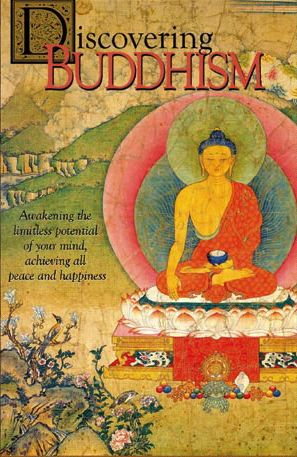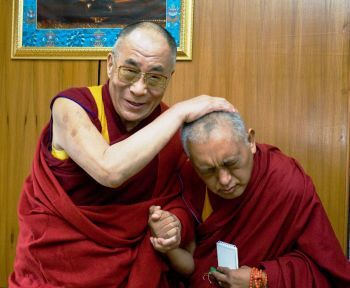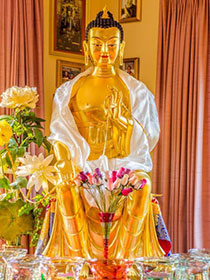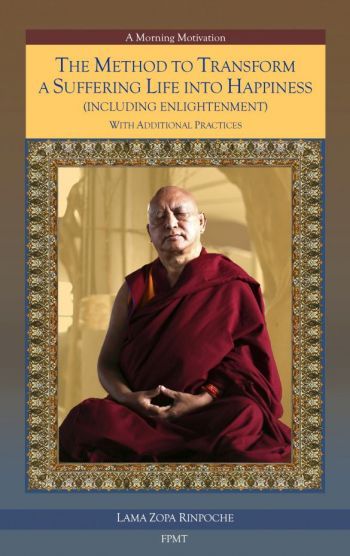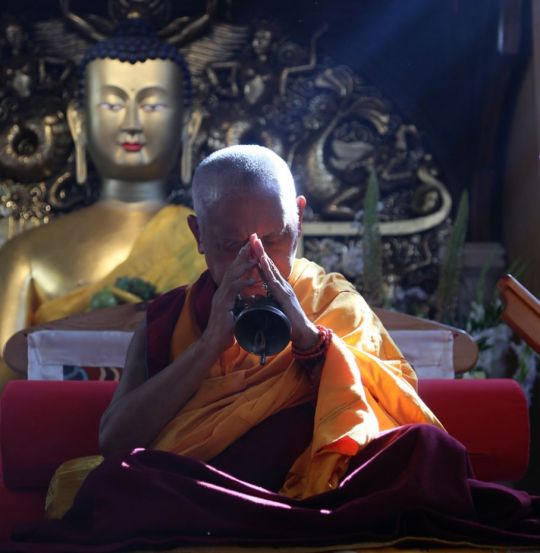- Home
- FPMT Homepage
Foundation for the Preservation of the Mahayana Tradition
The FPMT is an organization devoted to preserving and spreading Mahayana Buddhism worldwide by creating opportunities to listen, reflect, meditate, practice and actualize the unmistaken teachings of the Buddha and based on that experience spreading the Dharma to sentient beings. We provide integrated education through which people’s minds and hearts can be transformed into their highest potential for the benefit of others, inspired by an attitude of universal responsibility and service. We are committed to creating harmonious environments and helping all beings develop their full potential of infinite wisdom and compassion. Our organization is based on the Buddhist tradition of Lama Tsongkhapa of Tibet as taught to us by our founders Lama Thubten Yeshe and Lama Thubten Zopa Rinpoche.
- Willkommen
Die Stiftung zur Erhaltung der Mahayana Tradition (FPMT) ist eine Organisation, die sich weltweit für die Erhaltung und Verbreitung des Mahayana-Buddhismus einsetzt, indem sie Möglichkeiten schafft, den makellosen Lehren des Buddha zuzuhören, über sie zur reflektieren und zu meditieren und auf der Grundlage dieser Erfahrung das Dharma unter den Lebewesen zu verbreiten.
Wir bieten integrierte Schulungswege an, durch denen der Geist und das Herz der Menschen in ihr höchstes Potential verwandelt werden zum Wohl der anderen – inspiriert durch eine Haltung der universellen Verantwortung und dem Wunsch zu dienen. Wir haben uns verpflichtet, harmonische Umgebungen zu schaffen und allen Wesen zu helfen, ihr volles Potenzial unendlicher Weisheit und grenzenlosen Mitgefühls zu verwirklichen.
Unsere Organisation basiert auf der buddhistischen Tradition von Lama Tsongkhapa von Tibet, so wie sie uns von unseren Gründern Lama Thubten Yeshe und Lama Thubten Zopa Rinpoche gelehrt wird.
- Bienvenidos
La Fundación para la preservación de la tradición Mahayana (FPMT) es una organización que se dedica a preservar y difundir el budismo Mahayana en todo el mundo, creando oportunidades para escuchar, reflexionar, meditar, practicar y actualizar las enseñanzas inconfundibles de Buda y en base a esa experiencia difundir el Dharma a los seres.
Proporcionamos una educación integrada a través de la cual las mentes y los corazones de las personas se pueden transformar en su mayor potencial para el beneficio de los demás, inspirados por una actitud de responsabilidad y servicio universales. Estamos comprometidos a crear ambientes armoniosos y ayudar a todos los seres a desarrollar todo su potencial de infinita sabiduría y compasión.
Nuestra organización se basa en la tradición budista de Lama Tsongkhapa del Tíbet como nos lo enseñaron nuestros fundadores Lama Thubten Yeshe y Lama Zopa Rinpoche.
A continuación puede ver una lista de los centros y sus páginas web en su lengua preferida.
- Bienvenue
L’organisation de la FPMT a pour vocation la préservation et la diffusion du bouddhisme du mahayana dans le monde entier. Elle offre l’opportunité d’écouter, de réfléchir, de méditer, de pratiquer et de réaliser les enseignements excellents du Bouddha, pour ensuite transmettre le Dharma à tous les êtres. Nous proposons une formation intégrée grâce à laquelle le cœur et l’esprit de chacun peuvent accomplir leur potentiel le plus élevé pour le bien d’autrui, inspirés par le sens du service et une responsabilité universelle. Nous nous engageons à créer un environnement harmonieux et à aider tous les êtres à épanouir leur potentiel illimité de compassion et de sagesse. Notre organisation s’appuie sur la tradition guéloukpa de Lama Tsongkhapa du Tibet, telle qu’elle a été enseignée par nos fondateurs Lama Thoubtèn Yéshé et Lama Zopa Rinpoché.
Visitez le site de notre Editions Mahayana pour les traductions, conseils et nouvelles du Bureau international en français.
Voici une liste de centres et de leurs sites dans votre langue préférée
- Benvenuto
L’FPMT è un organizzazione il cui scopo è preservare e diffondere il Buddhismo Mahayana nel mondo, creando occasioni di ascolto, riflessione, meditazione e pratica dei perfetti insegnamenti del Buddha, al fine di attualizzare e diffondere il Dharma fra tutti gli esseri senzienti.
Offriamo un’educazione integrata, che può trasformare la mente e i cuori delle persone nel loro massimo potenziale, per il beneficio di tutti gli esseri, ispirati da un’attitudine di responsabilità universale e di servizio.
Il nostro obiettivo è quello di creare contesti armoniosi e aiutare tutti gli esseri a sviluppare in modo completo le proprie potenzialità di infinita saggezza e compassione.
La nostra organizzazione si basa sulla tradizione buddhista di Lama Tsongkhapa del Tibet, così come ci è stata insegnata dai nostri fondatori Lama Thubten Yeshe e Lama Zopa Rinpoche.
Di seguito potete trovare un elenco dei centri e dei loro siti nella lingua da voi prescelta.
- 欢迎 / 歡迎
简体中文
“护持大乘法脉基金会”( 英文简称:FPMT。全名:Foundation for the Preservation of the Mahayana Tradition) 是一个致力于护持和弘扬大乘佛法的国际佛教组织。我们提供听闻,思维,禅修,修行和实证佛陀无误教法的机会,以便让一切众生都能够享受佛法的指引和滋润。
我们全力创造和谐融洽的环境, 为人们提供解行并重的完整佛法教育,以便启发内在的环宇悲心及责任心,并开发内心所蕴藏的巨大潜能 — 无限的智慧与悲心 — 以便利益和服务一切有情。
FPMT的创办人是图腾耶喜喇嘛和喇嘛梭巴仁波切。我们所修习的是由两位上师所教导的,西藏喀巴大师的佛法传承。
繁體中文
護持大乘法脈基金會”( 英文簡稱:FPMT。全名:Found
ation for the Preservation of the Mahayana Tradition ) 是一個致力於護持和弘揚大乘佛法的國際佛教組織。我們提供聽聞, 思維,禪修,修行和實證佛陀無誤教法的機會,以便讓一切眾生都能 夠享受佛法的指引和滋潤。 我們全力創造和諧融洽的環境,
為人們提供解行並重的完整佛法教育,以便啟發內在的環宇悲心及責 任心,並開發內心所蘊藏的巨大潛能 — 無限的智慧與悲心 – – 以便利益和服務一切有情。 FPMT的創辦人是圖騰耶喜喇嘛和喇嘛梭巴仁波切。
我們所修習的是由兩位上師所教導的,西藏喀巴大師的佛法傳承。 察看道场信息:
- FPMT Homepage
- News/Media
-
- Study & Practice
-
-
- About FPMT Education Services
- Latest News
- Programs
- New to Buddhism?
- Buddhist Mind Science: Activating Your Potential
- Heart Advice for Death and Dying
- Discovering Buddhism
- Living in the Path
- Exploring Buddhism
- FPMT Basic Program
- FPMT Masters Program
- FPMT In-Depth Meditation Training
- Maitripa College
- Lotsawa Rinchen Zangpo Translator Program
- Universal Education for Compassion & Wisdom
- Online Learning Center
-
- Prayers & Practice Materials
- Overview of Prayers & Practices
- Full Catalogue of Prayers & Practice Materials
- Explore Popular Topics
- Benefiting Animals
- Chenrezig Resources
- Death & Dying Resources
- Lama Chopa (Guru Puja)
- Lama Zopa Rinpoche: Compendium of Precious Instructions
- Lama Zopa Rinpoche: Life Practice Advice
- Lama Zopa Rinpoche Practice Series
- Lamrim Resources
- Mantras
- Prayer Book Updates
- Purification Practices
- Sutras
- Thought Transformation (Lojong)
- Audio Materials
- Dharma Dates - Tibetan Calendar
- Translation Services
- Publishing Services
- Ways to Offer Support
- Prayers & Practice Materials
-
- Teachings and Advice
- Find Teachings and Advice
- Lama Zopa Rinpoche Advice Page
- Lama Zopa Rinpoche: Compendium of Precious Instructions
- Lama Zopa Rinpoche Video Teachings
- ༧སྐྱབས་རྗེ་བཟོད་པ་རིན་པོ་ཆེ་མཆོག་ནས་སྩལ་བའི་བཀའ་སློབ་བརྙན་འཕྲིན།
- Podcasts
- Lama Yeshe Wisdom Archive
- Buddhism FAQ
- Dharma for Young People
- Resources on Holy Objects
- Teachings and Advice
-
-
*If a menu item has a submenu clicking once will expand the menu clicking twice will open the page.
-
-
- Centers
-
- Teachers
-
- Projects
-
-
-
-
*If a menu item has a submenu clicking once will expand the menu clicking twice will open the page.
-
-
- FPMT
-
-
-
-
-
If you listen to the advice of the Buddha – who has only compassion for sentient beings and no trace of self-centred mind; who is perfect in power, wisdom and compassion; whose holy mind is omniscient – all you get is benefit.
Lama Zopa Rinpoche
-
-
-
- Shop
-
-
-
The Foundation Store is FPMT’s online shop and features a vast selection of Buddhist study and practice materials written or recommended by our lineage gurus. These items include homestudy programs, prayers and practices in PDF or eBook format, materials for children, and other resources to support practitioners.
Items displayed in the shop are made available for Dharma practice and educational purposes, and never for the purpose of profiting from their sale. Please read FPMT Foundation Store Policy Regarding Dharma Items for more information.
-
-
Advice from Lama Zopa Rinpoche
8
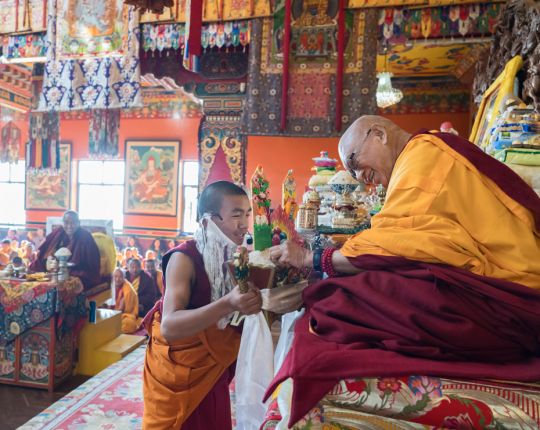
Lama Zopa Rinpoche during a puja on Losar, Kopan Monastery, February 2019. Photo by Ven. Lobsang Sherab.
Advice from Lama Zopa Rinpoche on what to think anytime you are doing a puja:
When doing any puja, you can think, “I am doing this puja for any sentient being who needs this puja.” So motivate for everyone, not for your work or for yourself, and not for money. Then doing the puja becomes Dharma, because of the pure motivation, because of your thought to benefit others.
Then also dedicate for people who are dying or sick, or for anyone who needs it. So all those people who are in so much need for prayers, the puja is for all of them. Whatever you do, try to benefit sentient beings, not just recite prayers.
The whole Buddha Dharma comes to this: to not harm others, and then to benefit others. Just having the mere thought to benefit someone is better than making offerings to numberless Buddhas.
If you follow the mind, which is unsubdued, that harms you and harms numberless sentient beings from life to life. If you practice the good heart, then it only benefits you from life to life.
How do the Kadampa Geshes practice the holy Dharma? They give up their lives for numberless sentient beings, thinking about what is the best for sentient beings. So even when facing sickness or death, think about whatever is of most benefit for sentient beings.
Colophon: Scribed by Ven. Holly Ansett, US, March 2018. Lightly edited by Laura Miller.
See new photos of Lama Zopa Rinpoche in Nepal and India. Find all photo albums of Rinpoche:
https://fpmt.org/teachers/zopa/gallery/
Find complete videos of Lama Zopa Rinpoche’s recent teachings:
https://fpmt.org/media/streaming/teachings-of-lama-zopa-rinpoche/
Lama Zopa Rinpoche is the spiritual director of the Foundation for the Preservation of Mahayana Tradition (FPMT), a Tibetan Buddhist organization dedicated to the transmission of the Mahayana Buddhist tradition and values worldwide through teaching, meditation, and community service.
- Tagged: lama zopa rinpoche, practice, puja
4
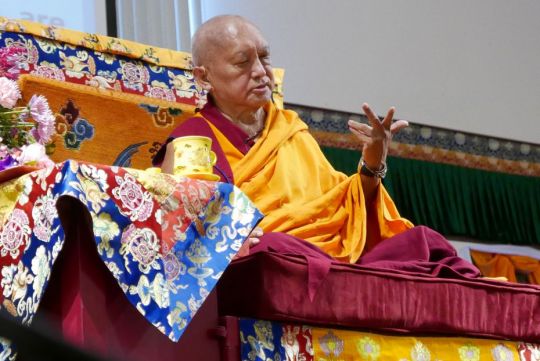
Lama Zopa Rinpoche teaching at the Light of the Path 2016 retreat, Black Mountain, North Carolina, US, August 2016. Photo by Ven. Roger Kunsang.
In August 2016, during the Light of the Path retreat, Lama Zopa Rinpoche advised students to check carefully when meditating on emptiness.
When many people meditate on emptiness they say that nothing exists. Do you understand? Nothing exists. [When you do that] you are not meditating on emptiness. You are meditating that things don’t exist even in mere name, doesn’t exist, nothing, doesn’t exist. Sorry to say this.
I’m sure I do that a lot. I think I do that a lot if I don’t check well. I think when I meditate I do that normal mistake: even in mere name doesn’t exist, complete nihilism, emptiness meditation that is nihilism. You understand?
Remember this: when you meditate on emptiness check to see whether you are meditating on nihilism or not. Make sure. Keep it in mind. Write it down.
This is a suggestion bringing up my own mistakes. Whether it is really meditating on emptiness, whether meditating on nihilism or not, you have to check.
The Prasangika view of emptiness has to be unified with dependent arising. Dependent arising has to be unified with emptiness. That is the Prasangika view of emptiness, the right view, of renunciation, bodhichitta, and emptiness; it is the right view. …
Watch more of Lama Zopa Rinpoche’s advice on meditating on emptiness in this video clip:
https://youtu.be/NGvh-62rWh4
Colonphon: Excerpted from Lama Zopa Rinpoche’s teachings at Light of the Path 2016 retreat, Black Mountain, North Carolina, US, August 16, 2016. Simultaneously transcribed by Ven. Joan Nicell. Edited by Nicole Parisi-Smith and Laura Miller, August 2018.
Find complete videos of Lama Zopa Rinpoche’s recent teachings:
https://fpmt.org/media/streaming/teachings-of-lama-zopa-rinpoche/
Lama Zopa Rinpoche is the spiritual director of the Foundation for the Preservation of Mahayana Tradition (FPMT), a Tibetan Buddhist organization dedicated to the transmission of the Mahayana Buddhist tradition and values worldwide through teaching, meditation, and community service.
25
How to Find a Guru
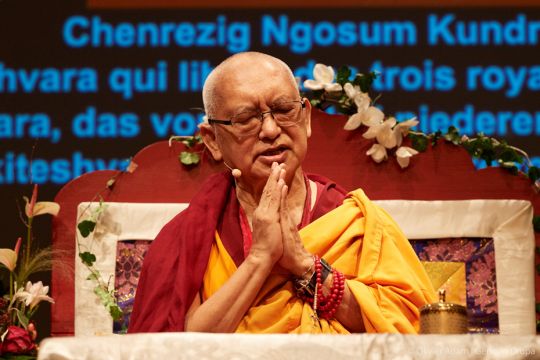
Lama Zopa Rinpoche at teachings organized by Gendun Drupa Center, Martigny, Switzerland, November 2018. Photo by Olivier Adam.
During the 2018 retreat in Australia, Lama Zopa Rinpoche explained how to find a guru, captured in this excerpt and video clip:
As I mentioned, even if you don’t have a guru but study, at least a short teaching, Liberation in the Palm of Your Hand, it’s so clear. That is so important. Then you know what you have to do if you want to follow a guru, if you want to practice. Then you know what to do.
Otherwise it is like looking for a boyfriend or girlfriend. You do the same thing—you make looking for a guru like looking for boyfriend or girlfriend. You do some teachings or initiation, then if you don’t like it, you give up, you throw out—not in the garbage, you can’t do that—but it is like that. Then you do it many times like that in this life.
You’re basically following people you know, they guide you, “Go to this lama, go to that lama.” Then another lama comes along. You don’t know how to practice. You don’t try to study. You don’t know that there is something to study. It’s just a very short time. Then another lama comes, just short time, comes and goes, disappears in the sky, ha-ha. Kind of like that. …
So you must read and study. Generally, people don’t know there is something to study, that there is something to read. They don’t know that. Maybe other people don’t tell, so you don’t know. So it is like that.
If you read, then you know whether you can [have them as your guru] or not. Then you see. All the benefits you come to know and all the shortcomings if you make mistakes. You have to be careful, most careful.
Last night I mentioned that just being famous, or just because the guru has many disciples, that alone that doesn’t mean [that you should have them as your guru]. In the West and in Chinese countries, they are very attracted to that, very attracted. Immediately you follow that. Then one without reputation, without many disciples, you give up. Then one with many disciples, very famous, you follow. It is kind of like that.
Many people are like that, because they don’t understand Dharma. Also I’m not saying everyone like that you can’t trust. I’m not saying that. But that alone is not the reason that you can trust them.
Kyabje Zong Rinpoche used to say, “If they are famous, they should be famous in the monasteries,” not just in the West, but famous in the monasteries—Tibetan monasteries, large monasteries. Nyingma and Kagyu have large monasteries. Gelug has Sera, Ganden, Drepung. That many people there trust them, it should be like that.
That is what Kyabje Zong Rinpoche said. He was one lama from who I received many teachings. He was Lama Yeshe’s guru as well. Kyabe Zong Rinpoche himself, and of course many others like him, were very famous in the monasteries. And now many people have known them for many years. That you can understand.
But even in the monasteries, there are many lamas and geshes with many thousands of disciples, so learned in philosophy, still it doesn’t mean you should make a connection with them as a guru immediately to receive teachings and initiations.
Watch the complete teaching “How to Find the Guru” from Lama Zopa Rinpoche:
https://youtu.be/VL5_XcvnPVI
Colophon: Excerpted from Lama Zopa Rinpoche’s teachings at the Great Stupa of Universal Compassion, Bendigo, Victoria, Australia, April 19, 2018. Simultaneously transcribed by Ven. Joan Nicell. Lightly edited by Laura Miller, February 2019.
Find complete videos of Lama Zopa Rinpoche’s recent teachings:
https://fpmt.org/media/streaming/teachings-of-lama-zopa-rinpoche/
Lama Zopa Rinpoche is the spiritual director of the Foundation for the Preservation of Mahayana Tradition (FPMT), a Tibetan Buddhist organization dedicated to the transmission of the Mahayana Buddhist tradition and values worldwide through teaching, meditation and community service.
- Tagged: essential extract, guru, lama zopa rinpoche, practice, video
22
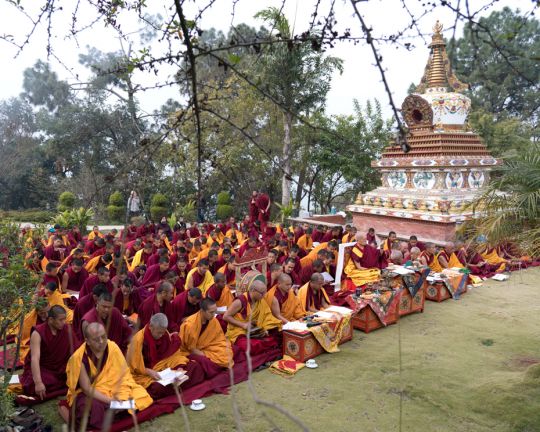
Lama Zopa Rinpoche and monks doing incense puja, Kopan Monastery, February 2019. Photo by Ven. Lobsang Sherab.
Lama Zopa Rinpoche sent this advice about developing a good heart to a student who had been offering healing classes at a center for twenty-five years.
As you know, caring for sentient beings, compassion for sentient beings, cherishing sentient beings, opens the door [to limitless qualities.] As it says in Lama Chöpa [LC92] by the great enlightened being Panchen Losang Chökyi Gyaltsen, and as the Buddha also said,
The mind that cherishes mothers and places them in bliss
Is the gateway leading to infinite qualities.
Seeing this, I seek your blessings to cherish these transmigratory beings
More than my life, even should they rise up as my enemies.
This is the best Dharma practice to help others and the best meditation, the best way to practice, the best healing. To develop the good heart and let them practice this is the best psychology, the best meditation, the best Dharma, the best everything. It is the quick way to achieve enlightenment, the quick way to free sentient beings from obscurations and bring them to full enlightenment quickly.
Below are two stories, examples of this. There are many other stories, many that I don’t know, these are just examples.
Asanga meditated in a cave for twelve years and tried to achieve Maitreya Buddha, but nothing happened. After twelve years he came down and saw a wounded dog covered in maggots on the road. He felt unbearable compassion, so he cut flesh from his thigh in order to pick up the maggots and put them on his flesh. He thought if he picked them up with his fingers he might hurt them, so he thought he must pick up each maggot with his tongue. He closed his eyes and stuck out his tongue to pick up the maggots. Suddenly in front of him was Maitreya Buddha, not the wounded dog.
Before, his mind was obscured and he only saw a wounded dog, but after generating unbelievable compassion he purified so much negative karma he had collected in the past. It was unbelievable purification, by generating compassion, and then he was able to see Maitreya Buddha. He immediately grabbed Maitreya’s robes and asked Maitreya Buddha why he had not come sooner, as he had tried to meditate for twelve years in the cave. He asked why he hadn’t seen Maitreya, and Maitreya Buddha replied, “I was there the whole time, but you could not see me. You know the place where you spat in the cave? That’s where I was.” Then Maitreya showed him the stains of spit on his robes.
The other story is about the great yogi Ngagpo Chöpawa who was going to Odi for the tantric practice of action. On the way, near the river, he saw a lady who was completely black in color, covered with leprosy and with pus coming out of her sores. She could not walk and asked him to take her across the river, but he ignored her.
After some time, his disciple Getsul Tsimbulwa came. He was not a gelong but a getsul, with thirty-six vows. The woman asked him the same thing, to take her across the river. Even though he was a monk and was not meant to touch women, he felt unbelievable compassion the minute he saw her, and immediately carried her across on his back. Because he generated unbelievable compassion for her, even though she was dirty and covered with leprosy, even without crossing the whole river, his negative karma was purified and in the middle of the river he saw her as Dorje Pagmo, an enlightened deity and she took him to the pure land of Dagpa Kachö.
Since our mind is ordinary, obscured, there are many things we see as ordinary, when they are not.
From Lama Zopa Rinpoche’s advice “The Advantages of Cherishing Others,” posted in January 2019 on the Lama Yeshe Wisdom Archive website:
https://www.lamayeshe.com/advice/advantages-cherishing-others
Lama Zopa Rinpoche is the spiritual director of the Foundation for the Preservation of Mahayana Tradition (FPMT), a Tibetan Buddhist organization dedicated to the transmission of the Mahayana Buddhist tradition and values worldwide through teaching, meditation and community service.
- Tagged: compassion, lama zopa rinpoche
8
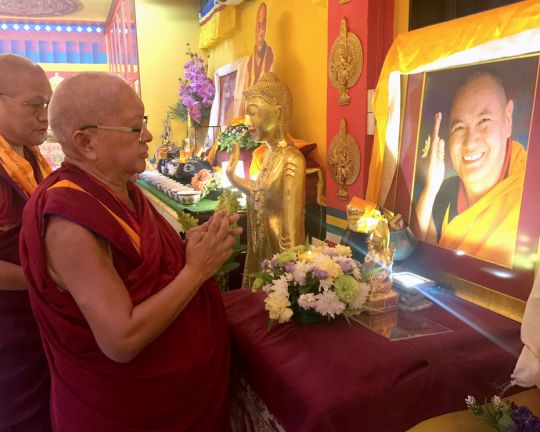
Lama Zopa Rinpoche offering a khata to a photo of Lama Yeshe at Losang Dragpa Centre, Malaysia, 2016. Photo by Ven. Roger Kunsang.
Six weeks after Lama Yeshe’s passing in 1984, Lama Zopa Rinpoche offered a personal tribute to his guru, Lama Yeshe. Here’s an excerpt from “Our Heart Jewel, Our Wish-granting Gem,” first published in Wisdom, #2 1984:
For those of us who have received teachings directly from Lama Yeshe, he was incomparably kinder than all the buddhas of the three times. He took care of us like babies, not only by giving teachings. Lama was more than a mother, more than a father to us, suffering as he did in everyday life for us.
He not only looked after our present life, but our future life also. He led us, helped us make preparation for happiness in this life all the way up to enlightenment.
For all of us it is the greatest sadness that Lama has passed away. We have lost our heart jewel, our wish-granting gem. The remarkable aspect that we can see, that we can communicate with, that we can hear advice from: this has gone.
I think it must be the greatest sadness not only for us, but for many other people also, Tibetan and Western, who are not his disciples; people who have just talked to Lama, or met him briefly when he was traveling, at different times and different places all over the world. Or for those who have only read Lama’s teachings or just heard his holy words. Even those who never saw Lama but only heard his voice on a tape recorder. All these people who have felt Lama’s great warmth, his special character, his great loving kindness, his unbearable compassion; I think Lama’s passing must be a great sadness for them, too.
Lama had such great will, such incredible dedication to work for others. He planned great projects, for the benefit of others and to spread the teachings. Not only did he have the visualization of all this but he was able to actualize it; he accomplished his plans, ensured that they were done, he didn’t just imagine them.
There are many learned lamas and geshe, all bearing the name “holy being” and practicing and teaching Dharma, in the East and in the West. And of them Lama is known to be very special; his actions unbearably compassionate, so excellent. The way Lama gave teachings to Western people especially: so suitable, exactly what was needed, perfect for each individual person.
When the sun rises the darkness of the earth is dispelled. In the same way the darkness of ignorance and problems in the mind of so many sentient beings around the world have been dispelled by the sun of Lama’s teachings. Because of him these past few years, since we first met the Russian princess Zina—so much Dharma has spread to dispel the darkness of ignorance. …
Read more from Rinpoche’s tribute to Lama Yeshe:
https://fpmt.org/mandala/archives/older/mandala-for-1984/wisdom-2-1984/our-heart-jewel-our-wish-granting-gem/
Lama Zopa Rinpoche is the spiritual director of the Foundation for the Preservation of Mahayana Tradition (FPMT), a Tibetan Buddhist organization dedicated to the transmission of the Mahayana Buddhist tradition and values worldwide through teaching, meditation and community service.
- Tagged: lama yeshe, lama zopa rinpoche
4
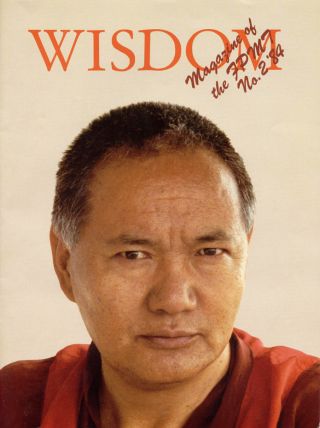
Cover of Wisdom, Number 2 1984. Photo of Lama Yeshe by Ueli Minder, taken in Geneva, Switzerland, 1983.
The Tibetan New Year, Losar, falls on February 5 this year. For FPMT students, this day has additional significance as it commemorates the anniversary of the parinirvana of Lama Yeshe, who co-founded FPMT with Lama Zopa Rinpoche.
Lama Yeshe’s heart stopped beating just before dawn on Losar, March 3, 1984. He was forty-nine years old.
In 1959, Lama Yeshe fled the Chinese Communists in Tibet, going into exile in India. He survived tremendous hardship living as a refugee monk in Buxa Duar, where Lama Zopa Rinpoche became his student.
Then in 1967, the two lamas began teaching Western students, leading to the establishment and flourishing of Kopan Monastery in Nepal and the FPMT organization throughout the world.
As part of Lama Zopa Rinpoche’s advice on how to celebrate Losar and the Fifteen Days of Miracles, Rinpoche recommends that centers host events to introduce new students to Lama Yeshe. These events might include students who knew Lama Yeshe sharing their favorite stories, watching videos of Lama teaching, or reading stories about Lama.
In that spirit, we’re highlighting Wisdom, Number 2 1984. Wisdom was the precursor to Mandala magazine. Its second issue, published not long after Lama Yeshe’s death, commemorated Lama. The issue included some of the last teaching from Lama Yeshe, a report on his passing, and tributes from Tibetan geshes as well as from Western students.
These words from Lama Yeshe’s teacher Geshe Lhundub Sopa Rinpoche, who knew Lama Yeshe at Sera Je Monastery in Tibet, reflect on Lama Yeshe’s goals and achievements:
“… During these past years Lama Yeshe has done so much beneficial activity for so many people, especially in the West. In fact, these two teachers, Lama Yeshe and Lama Zopa, have done such a wonderful job. The result is everywhere in the West—so many centers, so many students who follow the teachings seriously.
“And because of all this activity the students have such a wonderful opportunity to meet other teachers, to receive many, many instructions and teachings. Even in Tibet we didn’t have that kind of opportunity! To have high lamas teaching all the time and giving high initiations, to have all this available is very, very rare.
“So, when I see what has happened in the past few years, it makes me really happy, and I feel such admiration for Lama Yeshe and Lama Zopa and for their students. It is very difficult to follow a new religion coming from a different culture. It is not easy to accept and to follow deeply, but I see so many of you people are doing so, enthusiastically and with faith. I am really amazed when I see all this, and I rejoice and am very happy. …”
You can read the complete tribute from Geshe Lhundub Sopa Rinpoche:
https://fpmt.org/mandala/archives/older/mandala-for-1984/wisdom-2-1984/we-should-be-very-harmonious-and-try-to-help-each-other/
Find all the article from Wisdom, Number 2 1984:
https://fpmt.org/mandala/archives/older/mandala-for-1984/wisdom-2-1984/
Lama Zopa Rinpoche’s advice on practices for Losar and the Fifteen Days of Miracles:
https://fpmt.org/edu-news/ideas-and-advice-for-losar-and-the-fifteen-miracle-days-of-chotrul-duchen-2019/
Lama Zopa Rinpoche is the spiritual director of the Foundation for the Preservation of Mahayana Tradition (FPMT), a Tibetan Buddhist organization dedicated to the transmission of the Mahayana Buddhist tradition and values worldwide through teaching, meditation and community service.
21
How to Benefit a Cat
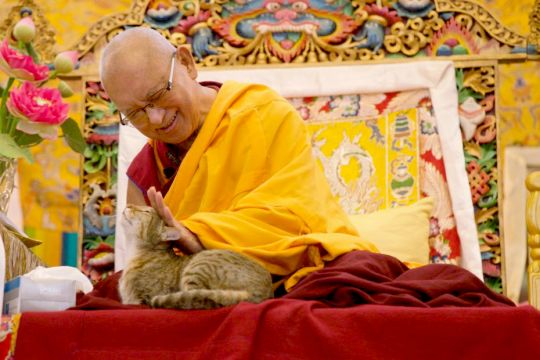
Lama Zopa Rinpoche petting Shamatha the cat who had jumped up onto Rinpoche’s throne, Kopan Monastery, Kathmandu, Nepal, December 2018. Photo by Bill Kane.
Lama Zopa Rinpoche gave the following advice to a student who had asked Rinpoche how to benefit a very sick twenty-one year old cat.
My most dear, most kind, most precious, wish-fulfilling one, I heard you wanted very much to come here but you have a cat that is twenty-one years old and is very sick, so you couldn’t come. I understand, that’s very good taking care of the cat.
It’s good to recite the Maitreya Buddha mantra in the cat’s ear. That causes the cat to never be reborn in the lower realms, to have a higher rebirth, and to meet the Dharma. Also recite Medicine Buddha mantra, Chenrezig Buddha mantra, Milarepa Buddha mantra, and Lotus Pinnacle of Amoghapasha mantra: OM PÄDMO USHNISHA VIMALE HUM PHAT. Recite these mantras several times each day.
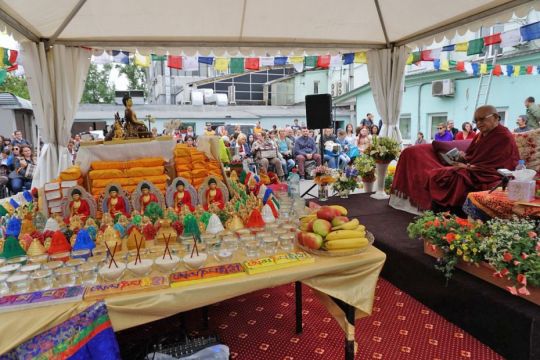
Lama Zopa Rinpoche at an Animal Blessing Day organized by Ganden Tendar Ling with relics, circumambulation of holy objects and altar table, and more, Moscow, Russia, May 2017. Photo by Ven. Lobsang Sherab.
Also recite the Three Principal Aspects of the Path and different lamrim prayers. The most important thing is to take the cat around holy objects. If you can, make an altar on a table and put many holy objects on the table, piled up—tsa-tsas, buddha statues, pictures, and texts, then take the cat around, on the same level as the altar. Put pictures of buddhas, statues, and tsa-tsas, as many as possible, then go around that.
However many holy objects are there—one hundred or one thousand— each time the cat goes around the holy objects, it creates that many causes of enlightenment. It is good to have many tsa-tsas there and to take the cat around them as much as you can before he dies, otherwise there is nothing much you can do.
Here is a powa pill. When the cat dies, put it on his crown with butter and honey.
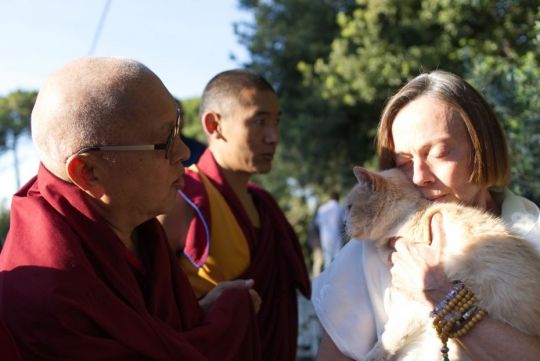
Lama Zopa Rinpoche reciting mantras for a very sick elderly cat, Istituto Lama Tzong Khapa, Pisa, Italy, October 2017. Photo by Ven. Lobsang Sherab.
It is very kind of you to take care of this cat for twenty-one years. Perhaps the cat could also be a recent family member, for example, if your father or mother died, or sometimes it could be your wife from a past life. It could be anything.
Please continue to make your life most meaningful for every sentient being with bodhichitta. Thank you very much. I hope to see you soon.
This advice, “Practices to Benefit a Cat,” is from “Lama Zopa Rinpoche’s Online Advice Book,” published in December 2018 on the Lama Yeshe Wisdom Archive website:
https://www.lamayeshe.com/advice/practices-benefit-cat
Lama Zopa Rinpoche is the spiritual director of the Foundation for the Preservation of Mahayana Tradition (FPMT), a Tibetan Buddhist organization dedicated to the transmission of the Mahayana Buddhist tradition and values worldwide through teaching, meditation, and community service.
- Tagged: animals, cat, lama yeshe wisdom archive, lama zopa rinpoche
18
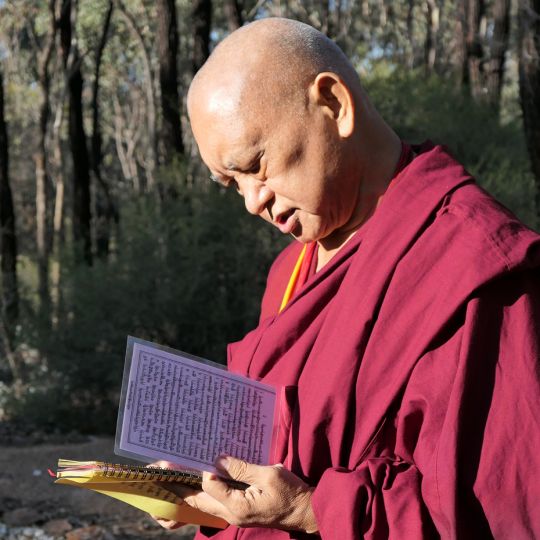
Lama Zopa Rinpoche doing water offering, preta offering, and offering to Dzambala near the Great Stupa of Universal Compassion, Bendigo, Australia, April 2018. Photo by Ven. Roger Kunsang.
Lama Zopa Rinpoche gave the following teaching during the retreat at the Great Stupa of Universal Compassion in Australia in April 2018:
Whatever you do to please the guru, just there [by doing that], without even doing many hundreds of thousands of prostration, your karma changes. If you’re going to be reborn in the lower realms, in the hell realms, just in that minute [that you please the guru], [your karma] changes to being born in a pure land, perfect human rebirth. You have to know this, and practice mindfulness.
Because of the guru’s kindness, it is like this. Whether you are with the guru or whether you are far away, it doesn’t matter. Just within that minute everything changes without needing to go through all these preliminary practices. You understand? You have to pick up the point. Like my teacher Geshe Rabten, you have to keep your mind always on the one thing that brings you to enlightenment quickest, that frees you from samsara quickest. Your whole life you meditate, meditate, but it is not sure [the result].
You have to understand the most important point—the profit in your life, not talking business profit but Dharma profit, the biggest profit, Dharma practice—the quickest way to achieve enlightenment and become free from samsara. You have to know this and practice this example, whether you are close to your guru or whether you are far.
By pleasing the guru all the buddhas become pleased. By fulfilling the guru’s holy wishes and advice, every day, every hour, minute, second, living in the vow, monk or nun or lay vow, whatever, I’m just giving different examples. In this way you fulfill the guru’s holy wishes and advice. Then also pleasing the guru by doing retreat, that retreat the guru advised, then with each mantra you recite, you get closer, very quickly, you become closer to liberation. You become free from samsara. Each time as you recite what the guru advised you, you get closer to enlightenment, each time you recite the mantra.
Even this work is fulfilling the guru’s wishes, advice. So the work you do—each step you walk in order to fulfill the guru’s wishes and advice, building a monastery, shopping, or whatever—each footstep you make, you become further from samsara and closer to enlightenment, closer to being free from samsara, and closer to bringing all sentient beings to enlightenment. Teaching Dharma, talking to people, or talking to the workers, whatever, doing what the guru advised, wishes, in each second you are further and further from samsara, instead of closer you become further from samsara and closer to enlightenment, to being able to free sentient beings from the oceans of samsaric sufferings and bring them to enlightenment. All that, closer and closer. Everything that is fulfilling the guru’s wishes and advice, for you the benefit is like that. …
Watch the complete teaching by Rinpoche on “The Most Essential Thing to Achieve Enlightenment”:
https://youtu.be/gbqxWtQenq4
Colophon: Excerpted from Lama Zopa Rinpoche’s teachings at the Great Stupa of Universal Compassion, Bendigo, Victoria, Australia, April 8, 2018. Simultaneously transcribed by Ven. Joan Nicell. Lightly edited by Laura Miller, February 2019.
Find complete videos of Lama Zopa Rinpoche’s recent teachings:
https://fpmt.org/media/streaming/teachings-of-lama-zopa-rinpoche/
Lama Zopa Rinpoche is the spiritual director of the Foundation for the Preservation of Mahayana Tradition (FPMT), a Tibetan Buddhist organization dedicated to the transmission of the Mahayana Buddhist tradition and values worldwide through teaching, meditation and community service.
- Tagged: essential extract, guru devotion, lama zopa rinpoche, video
14
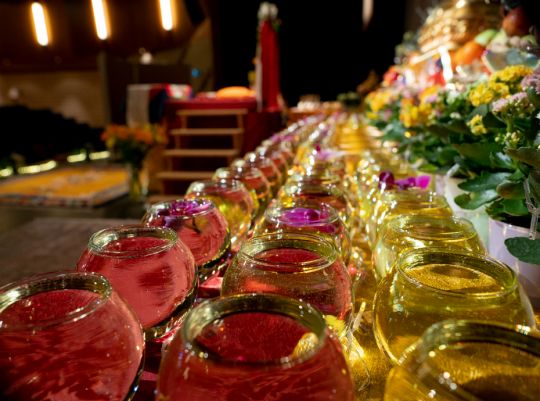
Water bowl offerings on the beautiful altar that was set up next to Lama Zopa Rinpoche’s throne during the teachings organized by Gendun Drupa Center, Martigny, Switzerland, November 2018. Photo by Harald Weichhart.
Lama Zopa Rinpoche wrote a group of sixteen retreatants who had completed 100,000 water bowl offerings together and offered their practice to Rinpoche. They asked if they could do preliminary practices in this way, doing the practices as group and counting what they had collectively done. Here’s Rinpoche’s response:
In Tibet this happened: there was a great lama in Amdo, I’ve forgotten his name, who went to the monastery to look for the text on Gyalwa Gyatso. Kirti Tsenshab Rinpoche advised of this. So this lama explained that in Tibet he put up a big tent and then many people made the water bowl offerings together. Then they offered them all together, so that means even though all the water bowls weren’t done by each person, the group counted them together. The lama used this technique in this way to finish them. Therefore, when you make an offering, you can offer even what has been offered by others.
I think similarly you can do this for light offerings. For example, even though many people have worked making the butter lamps and so forth, when you offer them you can offer them all and count them all. Like the water offerings, you can count all of them together.
Also, it’s the same with tsog offerings—even if the tsog is made by different people, when you offer it you can offer all the tsog together. So if there are one hundred people and they make a billion tsog offerings, then each person offers the billion tsog offerings.

Water bowl offerings on the altar at the teachings with Lama Zopa Rinpoche in Martigny, Switzerland, November 2018. Photo by Harald Weichhart.
But for other preliminary practices it isn’t the same. For example, if one person eats delicious ice cream, the other one hundred people or a billion people, or tens of thousands of people or one hundred thousand million billion people, don’t get the benefit of that one person eating ice cream.
I don’t think so, otherwise in that case, for example, if a monk eats ice cream does everyone feel like they have also eaten ice cream? When the monk’s stomach is full, is everybody’s stomach also full? When the monk is hungry, is everybody also hungry? When the monk eats potato pancakes, does everybody in France feel like they have eaten potato pancakes? If you can do that, then it’s OK.
When the monk does Vajrasattva practice, has everybody in the world done Vajrasattva? When the monk’s stomach is full after eating potato pancakes or eating momos, are all the people’s stomachs in the whole world full? Have they received the same momos or potato pancakes? If so, then it’s OK.
Anyway, from my heart I want to thank everyone, all the sixteen people, everybody. Billions of thanks for creating the cause of enlightenment. That means the cause of enlightenment for all the numberless sentient beings. That means each water bowl is done for the numberless hell beings’ enlightenment, the numberless hungry ghosts’ enlightenment, the numberless animals’ enlightenment—every mosquito, every single ant, every maggot, every slug, every spider—for all their enlightenment. Wow, wow, wow, wow, wow! Every water bowl has been done for the human beings in the numberless universes, and for the numberless suras and numberless asuras. Wow, wow, wow, wow, wow ! Thank you, thank you, thank you, thank you!
From “Water Bowl Offerings as a Group Practice,” posted in Lama Zopa Rinpoche’s Online Advice Book in November 2018 on the Lama Yeshe Wisdom Archive:
https://www.lamayeshe.com/advice/water-bowl-offerings-group-practice
For more about water bowl offering, FPMT Education Services has created “The Preliminary Practice of Altar Set-up & Water Bowl Offerings” available from the FPMT Foundation Store as an ebook and PDF:
https://shop.fpmt.org/The-Preliminary-Practice-of-Altar-Set-up-Water-Bowl-Offerings-eBook_p_2577.html
“The Preliminary Practice of Altar Set-up & Water Bowl Offerings” is also available as a print booklet:
https://shop.fpmt.org/The-Preliminary-Practice-of-Altar-Set-up-Water-Bowl-Offerings-_p_339.html
Lama Zopa Rinpoche is the spiritual director of the Foundation for the Preservation of Mahayana Tradition (FPMT), a Tibetan Buddhist organization dedicated to the transmission of the Mahayana Buddhist tradition and values worldwide through teaching, meditation and community service.
- Tagged: lama zopa rinpoche, water bowl offering
31
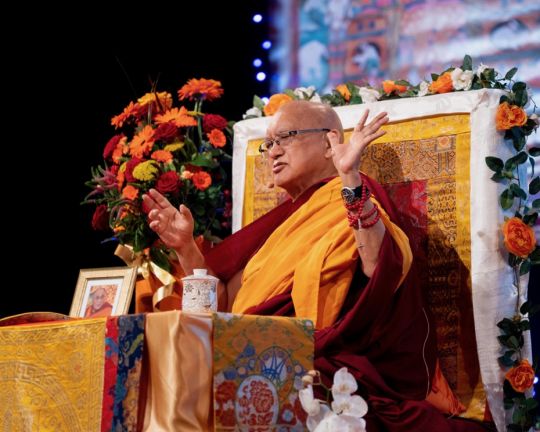
Lama Zopa Rinpoche teaching at the Reithalle, hosted by Aryatara Institute, Munich, Germany, November 2018. Photo by Harald Weichhart.
“Of course by purifying negative karma collected since beginningless rebirth and by collecting extensive merits, this allows you to have realizations on the path to enlightenment and for your mind to change,” Lama Zopa Rinpoche wrote to a student who offered 100,000 Vajrasattva mantras to Rinpoche. “There is always hope the mind can change, even to achieve enlightenment, so you can achieve a higher rebirth, ultimate happiness, liberation from samsara and enlightenment.
“Vajrasattva practice is so important generally, and especially nowadays in the world, when there is not only global warming, but many other problems. There are so many other dangers—of war and sicknesses, cancer, and so many people whom you know are dying. There are so many sicknesses and other conditions for dying.
“This Vajrasattva practice and other purification practices are the ultimate answer, so everything in the world—what you see, every situation—tells you to practice Vajrasattva. To purify and do Vajrasattva practice is the ultimate answer, to stop the cause to be reborn in the lower realms and the immediate [result] is to have a higher rebirth, to make preparation for death and then to meet the Dharma, to meet the virtuous friend who reveals the path to enlightenment. Then to achieve ultimate happiness, to be free from samsara and to achieve enlightenment for the numberless sentient beings and to free them from the oceans of samsaric sufferings and bring them to full enlightenment.”
From “Benefits of Vajrasattva Practice,” posted in “Lama Zopa Rinpoche’s Online Advice Book”:
https://www.lamayeshe.com/advice/lama-zopa-rinpoches-online-advice-book
The FPMT Foundation Store offers many resources to support students in their Vajrasattva practice:
https://shop.fpmt.org/search.asp?keyword=vajrasattva&search=
More information, photos and updates about FPMT spiritual director Lama Zopa Rinpoche can be found on Rinpoche’s webpage on FPMT.org. If you’d like to receive news of Lama Zopa Rinpoche and FPMT via email, sign up to FPMT News.
- Tagged: lama zopa rinpoche, vajrasattva
11
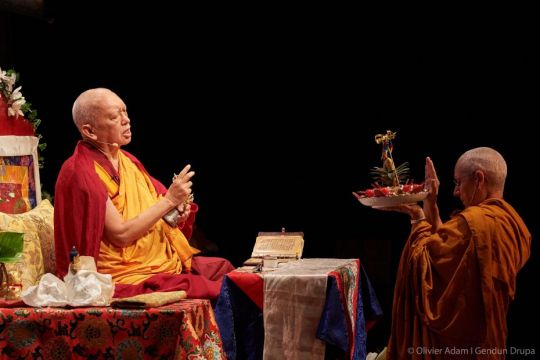
Tsog offering during Lama Zopa Rinpoche’s teachings in Martigny, Switzerland, November 2018. Photo by Olivier Adam.
Lama Zopa Rinpoche received many messages wishing him “Happy Birthday” this year. So on Rinopche’s birthday, which is December 3, he recorded a video message as a thank you to all who offered him birthday greetings.
In the video, Rinpoche gives advice on how to best see one’s birthday and the practices that can be done that become the causes for total and complete enlightenment for oneself and for all sentient beings.
Watch Lama Zopa Rinopche’s Birthday Message:
https://youtu.be/ajT7srFuHw8
You can find the transcript of Rinpoche’s birthday message here:
https://fpmt.org/wp-content/uploads/2018/12/11/a-birthday-message-from-lama-zopa-rinpoche/Lama-Zopa-Rinpoche-Birthday-Message-20181203.pdf
Find complete videos of Lama Zopa Rinpoche’s teachings, including recent teachings in Switzerland, Germany, Spain, and Kopan Monastery:
https://fpmt.org/media/streaming/teachings-of-lama-zopa-rinpoche/
FPMT.org and Mandala Publications brings you news of Lama Zopa Rinpoche and of activities, teachings, and events from over 160 FPMT centers, projects, and services around the globe. If you like what you read, consider becoming a Friend of FPMT, which supports our work.
3
Lama Zopa Rinpoche sent a special video message to Jamyang Buddhist Centre in London, describing the importance and benefit of having a Dharma center.
Rinpoche’s message was in honor of Jamyang’s fortieth anniversary, which was marked with two days of events in October.
The celebration included an evening remembering Lama Yeshe, the launch of the Cafe at Jamyang’s cookbook, a presentation on the history of Jamyang, cake, a group photo, and a look toward the center’s future.
In the video, Rinpoche thanks all the people who have helped Jamyang exist over the years.
Rinpoche also explains how FPMT centers can bring peace to the world by teaching people about compassion and how to develop a good heart.
Watch Lama Zopa Rinpoche’s Message Celebrating Jamyang Buddhist Centre’s 40 Anniversary:
https://youtu.be/8NCHapZcHgQ
Learn more about Jamyang Buddhist Center:
https://www.jamyang.co.uk/
Find complete videos of Lama Zopa Rinpoche’s recent teachings:
https://fpmt.org/media/streaming/teachings-of-lama-zopa-rinpoche/
Lama Zopa Rinpoche is the spiritual director of the Foundation for the Preservation of Mahayana Tradition (FPMT), a Tibetan Buddhist organization dedicated to the transmission of the Mahayana Buddhist tradition and values worldwide through teaching, meditation and community service.
- Home
- News/Media
- Study & Practice
- About FPMT Education Services
- Latest News
- Programs
- New to Buddhism?
- Buddhist Mind Science: Activating Your Potential
- Heart Advice for Death and Dying
- Discovering Buddhism
- Living in the Path
- Exploring Buddhism
- FPMT Basic Program
- FPMT Masters Program
- FPMT In-Depth Meditation Training
- Maitripa College
- Lotsawa Rinchen Zangpo Translator Program
- Universal Education for Compassion & Wisdom
- Online Learning Center
- Prayers & Practice Materials
- Overview of Prayers & Practices
- Full Catalogue of Prayers & Practice Materials
- Explore Popular Topics
- Benefiting Animals
- Chenrezig Resources
- Death & Dying Resources
- Lama Chopa (Guru Puja)
- Lama Zopa Rinpoche: Compendium of Precious Instructions
- Lama Zopa Rinpoche: Life Practice Advice
- Lama Zopa Rinpoche Practice Series
- Lamrim Resources
- Mantras
- Prayer Book Updates
- Purification Practices
- Sutras
- Thought Transformation (Lojong)
- Audio Materials
- Dharma Dates – Tibetan Calendar
- Translation Services
- Publishing Services
- Teachings and Advice
- Find Teachings and Advice
- Lama Zopa Rinpoche Advice Page
- Lama Zopa Rinpoche: Compendium of Precious Instructions
- Lama Zopa Rinpoche Video Teachings
- ༧སྐྱབས་རྗེ་བཟོད་པ་རིན་པོ་ཆེ་མཆོག་ནས་སྩལ་བའི་བཀའ་སློབ་བརྙན་འཕྲིན།
- Podcasts
- Lama Yeshe Wisdom Archive
- Buddhism FAQ
- Dharma for Young People
- Resources on Holy Objects
- Ways to Offer Support
- Centers
- Teachers
- Projects
- Charitable Projects
- Make a Donation
- Applying for Grants
- News about Projects
- Other Projects within FPMT
- Support International Office
- Projects Photo Galleries
- Give Where Most Needed
- FPMT
- Shop
Translate*
*powered by Google TranslateTranslation of pages on fpmt.org is performed by Google Translate, a third party service which FPMT has no control over. The service provides automated computer translations that are only an approximation of the websites' original content. The translations should not be considered exact and only used as a rough guide.Buddhism is not saying that objects have no beauty whatsoever. They do have beauty. The craving mind, however, projects onto an object something that is beyond the relative level, which has nothing to do with that object. That mind is hallucinating, deluded and holding the wrong entity.
